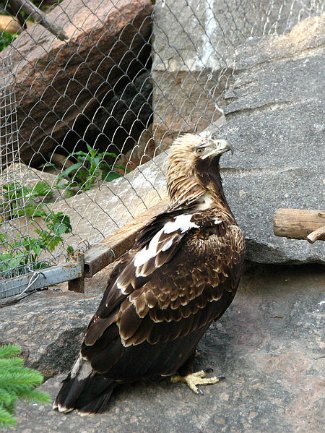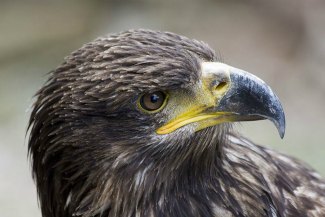Eastern Imperial Eagle - Aquila heliaca
Family: Accipitridae
Genus: Aquila
Species: A. heliaca
Eastern Imperial Eagles are large, powerful eagles that live across parts of Europe and Asia in a range of habitats. They form a clade with A. adalberti (Spanish Imperial eagle), A. nipalensis (Steppe Eagle), and A. rapax (Tawny Eagle), and a superspecies with A. adalberti.
Physical Description:
Eastern Imperial Eagles are almost entirely brown. The crown and sides of the neck are light gold, and the shoulders have white patches. The tail is dark gray with a black subterminal band tipped with white, and the wing coverts also have white edges. The undertail is a pale rust to cream color. Eyes and feet are yellow and the beak is gray with a black tip. Their wings and tail are long, and the head is large, as are the feet.
Juveniles are light brown with dark brown streaks on the head, breast, scapulars, and wings. The wing coverts have white tips and the underparts are buff.
Their call is a harsh, deep bark, repeated up to 8-10 times.
Size:
Length: 72-84 cm
Wingspan: 180-215 cm
Weight: 2.4-4.5 kg
Habitat and Distribution:
They are a lowland species, but due to habitat loss and hunting they have been pushed to higher elevations in Europe. They are found up to 1,800 meters above sea level, though they have been recorded as high as 3,900 m, in forests, steppes, and agricultural areas with trees, along with low hills and mountain slopes. In the Caucasus region, they are still found in lowland and riverine forests, along with semi-desert. Birds wintering in India were found in open desert, plains, wetland areas, and dry paddyfields; they are thought to prefer wetlands in their wintering grounds.
Eastern Imperial Eagles live from southern and central Europe to southern Russia, along with northwest India, northern Pakistan, Mongolia, and central Siberia; their summer range spans from 55°N to 35°N. In winter, they migrate to the Middle East, eastern Africa as far south as Tanzania, the Arabian Peninsula, the Indian subcontinent, and southern and eastern China; their winter range is from 50°N to 3°S. Occasionally they will gather into flocks of ten or more eagles when migrating, when they travel up to 8,000 km in six weeks. There are an estimated 5,200-16,800 individuals, across a range of 9,440,000 km².
Diet and Hunting:
They eat small mammals such as susliks (ground squirrels), marmots, gerbils, hamsters, and hares; reptiles including tortoises, insects, carrion; and birds such as goose, ducks, crows, pigeons, game birds, and even flamingos. In addition, they have also been recorded killing other raptors up to the size of Circus cyaneus (Northern Marsh Harrier). They rarely eat fish. Most of their live prey weighs under 2 kg.
By Pixelk, CC-BY-SA-3.0, via Wikimedia Commons
Hunting is done alone or with a partner. They sometimes steal food from other birds of prey, behavior known as kleptoparasitism. They also wait on the ground by rodent burrows for prey to emerge.
Reproduction:
Eastern Imperial Eagles mate for life, finding a partner at around age four. The breeding season is from February-July in Spain, and March-September in the rest of their range.
They build their nests out at the top of a tall tree, 10-20 meters above the ground. A single pair may have several nests, which they use in rotation, repairing them when they need to. The nests are 1.2-1.5 m across and 60-70 cm deep, though they can grow to be 2.4 m or more across and 1.8 m deep. They weigh up to 100 kg and are lined with twigs, fur, grass, and debris, with fresh vegetation brought throughout the nest’s use. 1-4 eggs are laid and incubated for 43-52 days by both parents. Siblicide, also called Cainism, is common, and the older and stronger chick will usually kill the younger. Fledging takes 63-77 days, but young will remain at the nest and be fed by the female until they can hunt on their own, around 160 days later.
Conservation:
Eastern Imperial Eagles face many threats including habitat loss, nest robbing, shooting and poisoning, illegal trading, electrocution along power lines, and prey shortages, particularly of susliks. These factors also extend to migrating eagles, so they do not affect just a single part of the population. Eastern Imperial Eagles have been listed as Vulnerable by BirdLife International.
Currently, they are legally protected in Azerbaijan, Bulgaria, Croatia, Georgia, Greece, Hungary, Romania, Slovakia, Turkey, and Ukraine. In 1990, the Eastern Imperial Eagle Working Group was established and in 1996 the Action Plan for the Imperial Eagle was published, both set up to help conserve the eagles.
Taxonomy:
Aquila heliaca was formerly considered to include Aquila adalberti (Spanish Imperial Eagle) as a subspecies, but they are now considered different species by some authorities due to morphological, ecological, and molecular differences. In addition, genetic studies have shown no evidence of gene flow between the two species. A. heliaca forms a monophyletic group with A. adalberti, A. nipalensis (Steppe Eagle), and A. rapax (Tawny Eagle).
Other Names:
Asian Imperial Eagle, Imperial Eagle, Shqiponja perandorake (Albanian), Orel královský (Czech), Kejserørn (Danish), Keizerarend (Dutch), Keisarikotka (Finnish), Aigle Impérial (French), Kaiseradler (German), Parlagi sas (Hungarian), Gammörn (Icelandic), Aquila imperiale (Italian), Katajirowashi (Japanese), Helang Tengkuk Kuning (Malay), Keiserørn (Norwegian), Orzel cesarki (Polish), Orol král'ovský (Slovakian), Águila Imperial Oriental (Spanish), Tai Kisogo-dhahabu (Swahili), Kejsarörn (Swedish).
Video of an Eastern Imperial Eagle:
References:
Gour, J. 2001. "Aquila heliaca" (On-line), Animal Diversity Web. Accessed November 23, 2011
http://animaldiversity.ummz.umich.edu/site/accounts/information/Aquila_heliaca.html.
http://www.arkive.org/imperial-eagle/aquila-heliaca/
http://avibase.bsc-eoc.org/species.jsp?avibaseid=469DCF57248A1C69
BirdLife International (2011) Species factsheet: Aquila heliaca. Downloaded from http://www.birdlife.org on 23/11/2011.
Global Raptor Information Network. 2011. Species account: Eastern Imperial Eagle Aquila heliaca. Downloaded from
http://www.globalraptors.org on 23 Nov. 2011
http://ibc.lynxeds.com/species/eastern-imperial-eagle-aquila-heliaca
http://www.imperialeagle.hu/parlagisasa.html
BirdLife International 2008. Aquila heliaca. In: IUCN 2011. IUCN Red List of Threatened Species. Version 2011.2.
www.iucnredlist.org. Downloaded on 23 November 2011.
http://www.planetofbirds.com/accipitriformes-accipitridae-imperial-eagle-aquila-heliaca
Ferguson-Lees, James, and Christie, David A. Raptors of the World. Houghton Mifflin Company, 2001.
http://www.waza.org/en/zoo/visit-the-zoo/birds-of-prey-1254385523/aquila-heliaca

